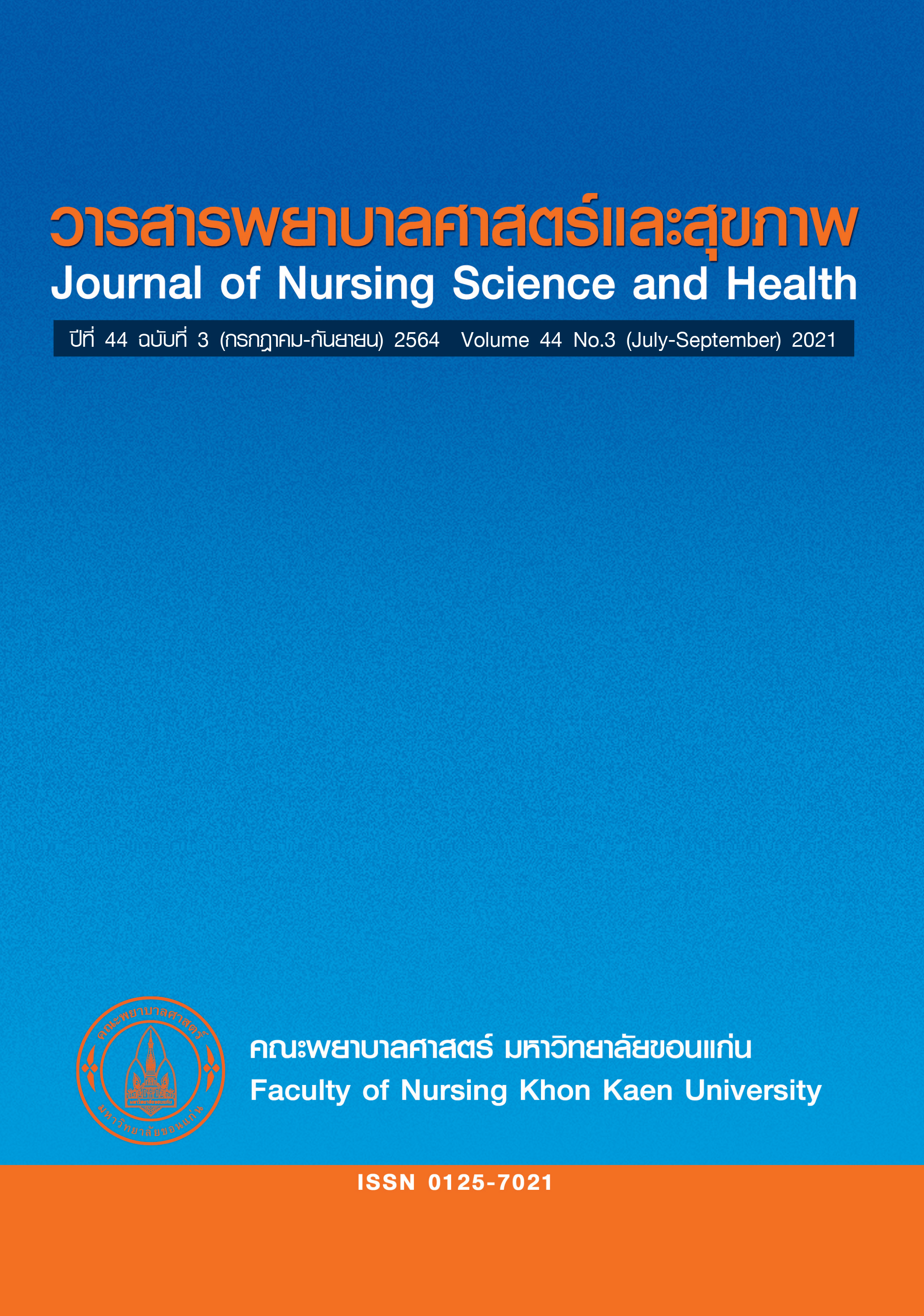ความเสี่ยงทางเพศสัมพันธ์ของวัยรุ่นผู้พิการทางการได้ยิน
คำสำคัญ:
วัยรุ่น, ผู้พิการทางการได้ยิน, พฤติกรรมเสี่ยงทางเพศสัมพันธ์บทคัดย่อ
วัยรุ่นผู้พิการทางการได้ยิน เป็นช่วงที่มีการเปลี่ยนผ่านระหว่างวัยเด็กสู่วัยผู้ใหญ่ และมีการเปลี่ยนแปลงด้านร่างกาย อารมณ์ สังคมเช่นเดียวกับวัยรุ่นปกติทั่วไป แต่วัยรุ่นผู้พิการทางการได้ยินมีพัฒนาการทางด้านภาษาล่าช้ากว่าวัยรุ่นปกติ และสื่อสารด้วยภาษามือเป็นหลัก ทำให้บางครั้งเกิดปัญหาในการรับข้อมูลจากผู้อื่น และการสื่อสารข้อมูลจากตนเองสู่ผู้อื่น คลาดเคลื่อนหรือผิดพลาดไปได้ ช่วงวัยรุ่นมีโอกาสเกิดพฤติกรรมเสี่ยงต่าง ๆ มากขึ้น เพราะเป็นช่วงวัยอยากรู้อยากเห็น มั่นใจในตนเองสูง อิทธิพลจากเพื่อนและสื่อมีผลต่อการแสดงออกของพฤติกรรมมากขึ้น โดยเฉพาะพฤติกรรมเสี่ยงทางเพศสัมพันธ์ในวัยรุ่นผู้พิการทางการได้ยิน เพราะส่วนใหญ่วัยรุ่นผู้พิการทางการได้ยินมีการพูดคุยสื่อสารข้อมูลเรื่องเพศสัมพันธ์ภายในกลุ่มผู้พิการทางการได้ยินด้วยกันเอง และจะเลียนแบบตามสื่อต่าง ๆ ไม่กล้าถามหรือพูดคุยกับพ่อแม่หรือกลุ่มปกติ เพราะการพูดคุยเรื่องเพศเป็นเรื่องน่าอาย แต่ข้อมูลที่วัยรุ่นผู้พิการทางการได้ยินเรียนรู้หรือพูดคุยกัน อาจมีความเข้าใจผิด เพราะสื่อส่วนใหญ่ไม่มีภาษามือในการอธิบายข้อมูล หรือวัยรุ่นผู้พิการทางการได้ยินตีความหมายจากผิดเป็นถูกจากสื่อที่รับ นำไปสู่การเกิดพฤติกรรมเสี่ยงทางเพศสัมพันธ์ได้ บทความวิชาการนี้ นำเสนอประเด็นความเสี่ยงทางเพศสัมพันธ์ของวัยรุ่นผู้พิการทางการได้ยิน 2 ประเด็น ได้แก่ พฤติกรรมทางเพศสัมพันธ์ และปัจจัยที่เกี่ยวข้องต่อการเกิดพฤติกรรมเสี่ยงทางเพศสัมพันธ์ในวัยรุ่นที่มีความพิการทางการได้ยิน เพื่อให้เห็นประเด็นที่ชักนำให้เกิดพฤติกรรมเสี่ยงทางเพศสัมพันธ์ชัดเจน หน่วยงานที่เกี่ยวข้องหรือบุคลากรทางการแพทย์สามารถส่งเสริมและป้องกันการเกิดพฤติกรรมเสี่ยงทางเพศสัมพันธ์ เพื่อให้วัยรุ่นผู้พิการทางการได้ยินมีการแสดงออกพฤติกรรมทางเพศสัมพันธ์ได้อย่างเหมาะสม
เอกสารอ้างอิง
Geers AE, Hayes H. Reading, writing and phonological processing skills of adolescents with 10 or more years of cochlear implant experience. Ear Hear 2011; 32(1): 49-59.
Siriattakul P, Jamnongchan S, Boonchuchuay W, Pimngern S. Development of the learning management model to enhance life skills of deaf early adolescents. Journal of Interdisciplinary Research: Graduate Studies 2015;4(3):1-14. (in Thai)
Department of mental health. Adolescent problem of mental health system integrations for Thai children project [Internet]. Bangkok: Department of mental health 2010 [cited 2020 Dec 18]. Available from: http://www.dmh.go.th/ downloadportal/Strategy.pdf. (in Thai)
Apakupakul N. Effectiveness of health education in human immunodeficiency virus (HIV)/acquired immune deficiency syndrome (AIDS) via a dual video for deaf students and normal students. Songklanagarind Medical Journal 2013;21(2):71-81. (in Thai)
Miller KR, Vernon M, Capella ME. Violent offenders in a deaf prison population. J Deaf Stud Deaf Educ 2005;10(4):417-25.
Hoyrat P, Wongsawat P, Factors influencing sexual intercourse behaviors among secondary school students. Journal of Health and Nursing Research 2019;36(1): 149-63. (in Thai)
Gomez MGA. Sexual behavior among filipino high school students who are deaf. Sex Disabil 2011;29:301-12.
Srion J. Preception of health information for deaf, case study : Educational institution of deaf students (audiovisual schools) [dissertation]. Nakhon Pathom: Mahidol Univ; 2008. (in Thai)
The momentum team and ThaiHealth Promotion Foundation. Youth media: how to communicate with deaf adolescent to understand and dare to talk about sexual health [Internet]. Bangkok: The momentum 2019 [update 2019 Nov 8 cited 2020 Dec 18]. Available from:https://themomentum.co/thai-health-disable-reproductive-health/. (in Thai)
Kolibiki HM. A study of emotional relationships among deaf adolescents. Procedia Soc Behav Sci. 2014;114:399-402.
Ajzen I. The theory of planned behavior, organizational behavior and human decision processes. Organizational Behavior and Human Decision Processes 1991;(50):179-211.
Heiman E, Haynes S, McKee M. Sexual health behaviors of deaf American Sign Language (ASL) Users. Disabil Health J 2015;8(4):1-15.
Kvam HM, Sexual abuse of deaf children. A retrospective analysis of the prevalence and characteristics of childhood sexual abuse among deaf adults in Norway. Child Abuse & neglect 2004; 28: 241-51.
Johnson H. Children with disabilities [Internet]. Huntsville: National Children's Advocacy Center; 2013 [cited 2019 Dec 18]. Available from: https://www.deafedchil dabuse-neglect-col.wiki.educ.msu.edu/.../AR+-+Causes+-+kid.
Job J. Factors involved in the ineffective dissemination of sexuality information to individuals who are deaf or hard of hearing. American Annals of the Deaf 2004; 149(3):264-73.
Chaisamdaeng P, Phuphaibul R, Patoomwan A. Effects of the computer game “Kid…Think” program on attitudes, norms, perceived behavioral control, and intention to not express sexual risk behaviors of deaf students in high school. [dissertation]. Nakhon Pathom: Mahidol Univ; 2020. (in Thai)
Nokdee C. Open the world love the shore, not safe [Internet]. Thai Health Promotion Foundation; 2019 [update 2019 Nov 1 cited 2020 Dec 18]. Available from: https://www.thaihealth.or.th/Content/50480-.html (in Thai)
Kamieka O, Gabriel S, Yvette Q. Parental training and involvement in sexuality education for students who are deaf. American Annals of the Deaf 2001;146(3):287-93.
Siriattakul P, Jamnongchan S, Boonchuchuay W, Pimngern S. Development of the learning management model to enhance life skills of deaf early adolescents. Journal of Interdisciplinary: Research graduate studies 2015;4(3):1-14. (in Thai)
Haruna H, Hu X, Chu SKW, Mellecker RR, Gabriel G, Ndekao PS, et al. Improving sexual health education programs for adolescent students through game-based learning and gamification. Int J Environ Res Public Health 2018;15:1-26.
Treacy C, Taylor S, Abernathy T. Sexual health education for individuals with disabilities: A call to action. American Journal of Sexuality Education 2017;13(1):65-93.
Office of the Permanent Secretary, Ministry of education. Problems and requirement to use educational material of teacher and deaf student in secondary school [Internet]. Bangkok: Office of the Permanent Secretary, Ministry of education; 2005 [cited 2020 Nov 20]. Available from: http://www.braille-cet.in. th/Braille-new/=content (in Thai)
Pupunhong W, Wuttisin K, Traitip T. Factors related to sexual behavior of teenagers in amphoe Meuang Kalasin Province. Journal of praewakalasin 2016; 3(2):54-72. (in Thai)
Unit for Children. Unicef Thailand. Situation analysis teen age pregnancy in Thailand [Internet]. Bangkok: Unicef Thailand; 2016 [cited 2020 Nov 20]. Available from: https://www.unicef.org/thailand/ media /1131/file/. (in Thai)
Smith CE, Massey-stokes M, Lieberth A. Health information need of deaf adolescent females: A call to action. Am Ann Deaf 2012; 157(1): 41-7.
Mingsiritham K, Chanyawudhiwan G. Development of smart books to support communication for children with hearing impairments [dissertation]. Bangkok: Sukothai Thammathirat Open Univ; 2019. (in Thai)
ดาวน์โหลด
เผยแพร่แล้ว
รูปแบบการอ้างอิง
ฉบับ
ประเภทบทความ
สัญญาอนุญาต
ลิขสิทธิ์ (c) 2021 วารสารพยาบาลศาสตร์และสุขภาพ

อนุญาตภายใต้เงื่อนไข Creative Commons Attribution-NonCommercial-NoDerivatives 4.0 International License.
วารสารพยาบาลศาสตร์และสุขภาพเป็นเจ้าของลิขสิทธิ์ในการเผยแพร่ผลงานที่ตีพิมพ์ห้ามผู้ใดนำบทความที่ได้รับการตีพิมพ์ในวารสารพยาบาลศาสตร์และสุขภาพไปเผยแพร่ในลักษณะต่าง ๆ ดังนี้ การนำบทความไปเผยแพร่ออนไลน์ การถ่ายเอกสารบทความเพื่อกิจกรรมที่ไม่ใช่การเรียนการสอน การส่งบทความไปตีพิมพ์เผยแพร่ที่อื่น ยกเว้นเสียแต่ได้รับอนุญาตจากวารสารพยาบาลศาสตร์และสุขภาพ



